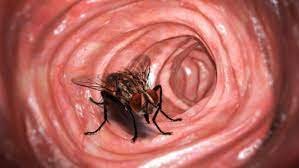A house fly was found intact during the colonoscopy of a 63-year-old Missouri guy. This has left US doctors stunned….
A colonoscopy in the US revealed a fully intact house fly in a man’s intestines, shocking doctors. The American Journal of Gastroenterology reported the finding after a 63-year-old Missouri man had a normal colon test. The colonoscopy went normally until the doctor found an intact fly in the transverse colon, the top of the big intestine. MU School of Medicine doctors reported in the article that an exceptional instance is a rare colonoscopic finding. How the intact fly reached the transverse colon is unknown.
An unidentified 63-year-old patient was also stunned by the finding and had no idea how the insect got into his body. He told doctors he had just clear drinks before his treatment and had pizza and salad two days previously without a fly on any of it. Doctors stated the man had no signs of using it.
The doctors reported in the journal that the fly did not move on its own or with scope manipulation. Matthew Bechtold, head of gastroenterology at the University of Missouri, told The Independent that he and other doctors found the fly dead.
The fly may have entered a man’s stomach through ingestion or the rectum, according to Mr. Bechtold. His colleagues doctors don’t know how the house fly entered the transverse colon. Make. Mr. Bechtold told the publication that if the fly entered the man’s mouth, “Upper digestive enzymes and stomach acid would have destroyed the fly. The idea is less likely because the fly was intact.
If from the bottom, a hole would have been formed long enough for the fly to travel undetected into the large intestine and somehow reach the middle without light in the very winding gut. However, “That seems unlikely,” Mr. Bechtold added.
Conclusion
A 63-year-old Missouri guy had a colonoscopy and found a fully intact house fly. A routine colon screening revealed the discovery, published in the American Journal of Gastroenterology. The fly was in the transverse colon, the top of the large intestine, and did not move with the scope. The unidentified patient was astonished by the discovery and had no indications of fly consumption.
The fly did not move with the scope or by itself. The fly was dead, according to University of Missouri gastroenterology head Matthew Bechtold. He thought the fly might have entered the man’s stomach through ingestion or his rectum. His colleagues doctors don’t know how the fly entered the transverse colon.
If the fly enters the man’s mouth, the hypothesis is less likely. It is improbable that the fly would have made it into the middle of the large intestine without illumination if a hole was formed from the bottom.



